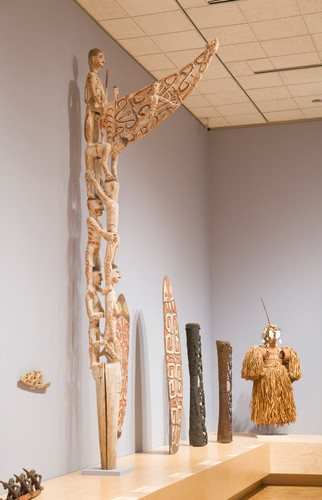Editor’s note: This is the second in an occasional series of stories that Bulletin Today will publish until the opening of the Anderson Student Center in January 2012.
The American Museum of Asmat Art, owned by the University of St. Thomas, is a collection of more than 2,000 pieces – ranging from sculptures to fiber art to shields – created by the Asmat people of Indonesia. Dedicated to its upkeep is art history faculty member Julia Risser, along with a roving team of faculty, grad assistants and student workers.

Asmat shield
With an enthusiastic team of experts and support from university leaders, the museum has a lot going for it. But what it doesn’t have is a singular, permanent home on St. Thomas’ campus.
That will change when the new Anderson Student Center opens in 2012.
On the second floor next to the offices of Campus Ministry, a curved glass wall facing the atrium will welcome visitors into an all-new gallery space that will house artifacts from the university’s collection of Asmat art.
“This is an exciting opportunity for the collection to be exposed to an even larger audience,” Risser said. “The collection will be shown in the way it deserves to be shown and will properly highlight the Asmat culture.”

Bisj pole
The gallery entry is designed for permanent installations of larger pieces – including the towering Bisj poles and the long, narrow soulship or “spirit canoe.” Adjacent to the entry, there will be a sizeable section where art history students will design their own exhibitions from the collection. According to Risser, “Our students will have a rare opportunity to take part in a pragmatic, hands-on professional experience.”
Students working in the gallery also will gain experience with object preservation. “To see something like an Asmat shield in a gallery is one thing. But to handle a shield – to feel its weight, to understand its delicateness – is an entirely different experience,” Risser said. With more than 2,000 pieces in the collection, the possibilities for future exhibitions seem limitless.
To Risser, the addition of a permanent gallery on campus signifies much more than simply giving space to this large collection. “It shows a long-term commitment from the university during these times when so many schools are cutting back and selling off their collections because of financial difficulties.”
The museum is one of two established by the American Crosier Fathers and Brothers since they began missionary work in 1958 with the Asmat, a tribal people indigenous to the southwest coast of the island of New Guinea — a region known as Irian Jaya or West Papua, Indonesia. The Crosiers, along with the Diocese of Agats in Papua, donated the entire collection to St. Thomas in 2007.
Since coming to St. Thomas, the collection hasn’t gone unnoticed. In 2009, the Minneapolis Institute of Arts showcased 72 objects from the collection in a four-month exhibition. And later that year, the museum received a Preservation Assistance Grant from the National Endowment for the Humanities.
Today, the museum, somewhat like the Asmat themselves, is a bit nomadic with portions of the collection on display in the O'Shaughnessy Educational Center, the O'Shaughnessy-Frey Library Center, the John R. Roach Center for Liberal Arts and the Brady Educational Center. There is also an Asmat shield on display on the second floor of Schulze Hall on the university’s Minneapolis campus. These installations are likely to stay in place when the new gallery opens.
For an interactive map of the new Anderson Student Center’s floor plans, visit the Opening Doors Campaign.






